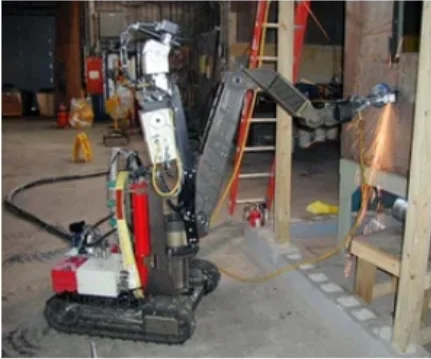Electric manipulators are an essential component of modern robotics systems. They provide the ability to move and manipulate objects with precision and accuracy, making them ideal for a wide range of applications. In this article, we will explore the versatility of electric manipulators in robotics, examining their use in various industries and applications.
What are Electric Manipulators?
Electric manipulators, also known as robotic arms or robot manipulators, are mechanical devices designed to mimic the movements and functions of a human arm. These versatile machines consist of multiple joints connected by rigid links or articulated segments that allow them to move in various directions. The joints are typically powered by electric motors, which enable precise control over their movements.
The design of electric manipulators is inspired by the complex structure and flexibility of the human arm. They can be equipped with a variety of end effectors such as grippers, suction cups, or specialized tools depending on the intended application. This allows them to handle objects of different shapes, sizes, and weights effortlessly.
One remarkable feature of electric manipulators is their ability to perform highly repetitive tasks with speed and accuracy. By programming specific sequences of movements and actions, these machines can carry out tasks such as pick-and-place operations on assembly lines or sorting items in warehouses efficiently.
Electric manipulators offer a wide range of motion capabilities. They can rotate along multiple axes simultaneously and reach into tight spaces that may be difficult for humans to access. This makes them ideal for applications like welding, painting, packaging, material handling, and even medical procedures.
How electric manipulators work
Electric manipulators are fascinating machines that play a crucial role in robotics. These versatile devices are designed to mimic human arm movements and perform various tasks with precision and accuracy. But how exactly do electric manipulators work?
At the heart of an electric manipulator is a system of motors, gears, and sensors that enable it to move and interact with objects in its environment. The motors provide the necessary power for movement, while the gears ensure smooth operation and control. Sensors help the manipulator perceive its surroundings, allowing it to make adjustments as needed.
The control system is another essential component of an electric manipulator. It receives input from an operator or a pre-programmed sequence of commands and translates them into specific movements for the robot arm. This level of control allows for precise positioning, gripping, and manipulation of objects.
Some electric manipulators also feature advanced technologies such as force feedback systems or vision systems. These additional capabilities enhance their ability to interact with objects more effectively.
Electric manipulators offer a combination of mechanical design, motor technology, sensing capabilities, and advanced control systems that allow them to perform intricate tasks in various industries like manufacturing, healthcare, logistics, and more.
In conclusion, understanding how electric manipulators work provides insight into their versatility and potential applications in different fields. Their ability to mimic human arm movements makes them valuable tools in automation processes where precision is key.

Advantages of Electric Manipulators
Electric manipulators offer a multitude of advantages that make them an essential component in the field of robotics. One significant advantage is their versatility. These manipulators can be easily programmed to perform various tasks, making them suitable for a wide range of applications.
Another advantage is their precision and accuracy. Electric manipulators are designed with advanced control systems that allow for precise movements and positioning. This level of precision is crucial in industries such as manufacturing, where even the slightest error can have significant consequences.
In addition to precision, electric manipulators also offer excellent repeatability. Once a task has been programmed, these devices can consistently replicate it with minimal variation. This not only increases efficiency but also reduces the chances of errors or inconsistencies occurring during repetitive tasks.
Furthermore, electric manipulators are known for their speed and agility. With fast response times and smooth movements, they can quickly adapt to changing situations and perform tasks at high speeds without compromising on accuracy.
Moreover, electric manipulators are often compact and lightweight compared to alternative options like hydraulic or pneumatic systems. This makes them easier to integrate into existing setups or deploy in confined spaces where size and weight limitations may apply.
One cannot overlook the energy efficiency offered by electric manipulators. By utilizing electrical power instead of other forms like hydraulic fluid or compressed air, these devices consume less energy overall while still delivering impressive performance levels.
Electric manipulators provide several advantages that make them indispensable in robotics applications across various industries. Their versatility, precision, repeatability, speed & agility, compactness & lightweight design along with energy efficiency contribute significantly towards enhancing productivity while ensuring cost-effectiveness.
Applications of Electric Manipulators in Robotics
Electric manipulators have become an integral part of the robotics industry, with a wide range of applications that showcase their versatility and efficiency. These advanced robotic devices are designed to mimic human hand movements and perform delicate tasks with precision. Let's explore some of the key applications where electric manipulators excel.
In manufacturing industries, electric manipulators are used for handling and assembling components on assembly lines. With their ability to grip and manipulate objects effortlessly, these robots can significantly enhance production efficiency while ensuring consistent quality. Whether it's picking up small electronic components or lifting heavy machinery parts, electric manipulators offer unmatched dexterity.
In the healthcare sector, electric manipulators play a vital role in assisting surgeons during complex surgical procedures. These robots provide steady hands and precise movements that minimize errors and improve patient outcomes. They can be utilized for tasks such as suturing wounds, performing minimally invasive surgeries, or even assisting in neurosurgery.
Another fascinating application is in the field of agriculture. Electric manipulators can be employed for tasks like harvesting fruits and vegetables or pruning plants with utmost care. This not only reduces labor costs but also increases productivity by enabling faster harvesting processes.
Furthermore, electric manipulators find extensive use in research laboratories for conducting experiments that require delicate handling or precise measurements. With their high degree of control over movements, these robots prove invaluable when working with fragile materials or carrying out intricate procedures.
The entertainment industry has also embraced the capabilities of electric manipulator technology by incorporating them into animatronics and special effects systems. Whether it's creating lifelike creature movements or enhancing virtual reality experiences through haptic feedback devices, these robots add an extra layer of realism to various forms of entertainment media.
These examples merely scratch the surface when it comes to the diverse applications of electric manipulators in robotics. As technology continues to advance at a rapid pace, we can expect further innovations that will expand their usage across different industries and domains.

Conclusion
Electric manipulators have become an indispensable tool in the field of robotics due to their versatility and efficiency. These advanced machines are capable of performing various tasks with precision.
In this article, we explore what electric manipulators are and how they work. We discuss the benefits they offer, such as increased productivity, improved safety and reduced human error. We also highlight some common applications of electric manipulators in robotics.
From manufacturing to healthcare, electric robots have revolutionized industries by streamlining processes and improving operational efficiency. Able to handle heavy objects, perform delicate movements and operate in confined spaces, these robotic arms have proven to be valuable assets to businesses around the world.
As technology continues to advance rapidly, we can expect more advancements in the capabilities of electric manipulators. From improved sensors for greater accuracy to better integration with artificial intelligence systems for autonomous operation, the future for these versatile machines is promising.
Whether assembling products on a production line or assisting surgeons during complex surgeries, electric manipulators continue to push boundaries and redefine what is possible in robotics. With its numerous advantages and cross-industry applications.
